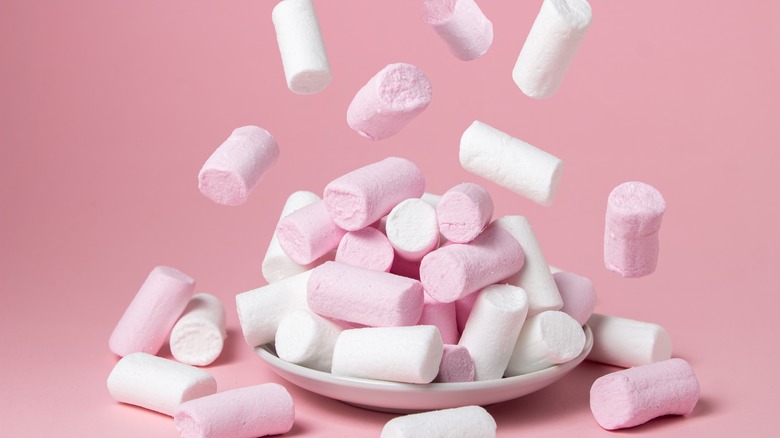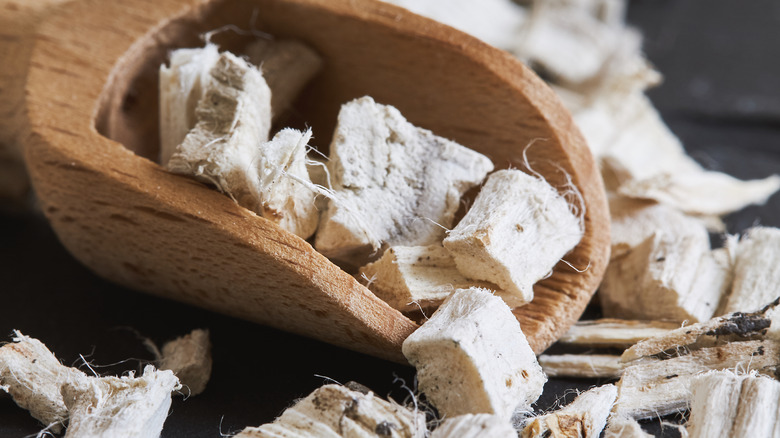What Are Marshmallows Actually Made Of?
Even if your grownup tastebuds eschew the gooey texture and sweetness of marshmallows, there's a pretty good chance you once loved them. In Western culture, they tie closely to nostalgic childhood memories, from roasting marshmallows over open campfires to gobbling them in crispy, chewy chunks of Rice Krispie treats. Elevating them to fancy desserts or pastel-plated mounds may be futile –– after all, it's likely the throwback appeal that really grabs the heartstrings, not the actual taste of those elongated mystery treats.
The continuing fascination with marshmallows as a food product begs the question: What are marshmallows actually made of? Once upon a time, what we now call marshmallows came from Mather Nature, believe it or not, and were considered food for royals, elites, or deities. Thousands of years later, they're hardly recognizable in form or flavor compared to the original ones, and they're made from only a handful of now-common ingredients: sugar, corn syrup, gelatin, and air — all of which are whipped into a frenzy.
It's possible to make them in a home kitchen, but there's an intricacy to the method, and it can require the addition of cornstarch and potentially other ingredients such as vanilla, water, or confectioner's sugar, per preference and recipe. It can also take hours to make when including the required resting time. In other words, those bags of store-bought marshmallows are likely to continue reigning in hot chocolate toppings and countless recipes for viscous deliciousness.
How today's marshmallow ingredients differ from original versions
In defense of today's marshmallows, which occasionally even land on lists touting America's Favorite Foods, they aren't just an indulgent sweet treat. In miniature form, slightly melted marshmallows are often spread across dishes such as sweet potatoes, particularly at holiday meals. There's even a thing called savory s'mores made with blue cheese and prosciutto or pepperonis. But the essential ingredient, the marshmallow, seldom diverges from its stretchy, sweet form.
The original marshmallow had only one of the ingredients used today: the sugar. Its core came from an actual root plant called mallow (Althaea officinalis), which grows wildly in marshy terrains –– thus the name marsh mallow. Early Egyptian marshmallow desserts used extracted sap from the plant combined with honey and chopped nuts. Europeans, French candy makers in particular, later started whipping the sap by hand and forming candies using molds.
Eventually, gelatin took the place of the natural mallow plant, serving as an air stabilizer and providing the necessary texture. Finally, in 1948, an American manufacturer invented a process called extrusion, funneling the marshmallow goo through tubes, and then cutting the resulting foam to form the shape we recognize today.
Are vegan marshmallows a thing?
None of today's marshmallow ingredients sit well with people who avoid certain foods, namely sugar and gelatin. In particular, marshmallows are off-limits for vegans and vegetarians — all because of the gelatin. In a nutshell, gelatin comes from animal bones as well as the tissue, cartilage, and skin. From these parts, processors take collagen and turn it into gelatin, which has a squiggly texture and no taste or color.
Gelatin also harbors high amounts of protein and has been used in skin care, bone health enhancement, brain health, and much more, according to Healthline. That doesn't mean the commercial marshmallows in grocery stores retain much — if any — nutritional or medicinal value –– unless you miraculously run across marshmallows made from the roots and leaves of a genuine mallow plant.
However, vegan versions of modern marshmallows are out there, albeit with a slightly less fluffy texture. Rather than using gelatin as the essential ingredient, a vegan marshmallow typically employs soy proteins or seaweed derivatives such as carrageenan. It works in a similar way to gelatin, but it won't be exactly like the chunky, soft, springy white treats residing in your childhood memories.



